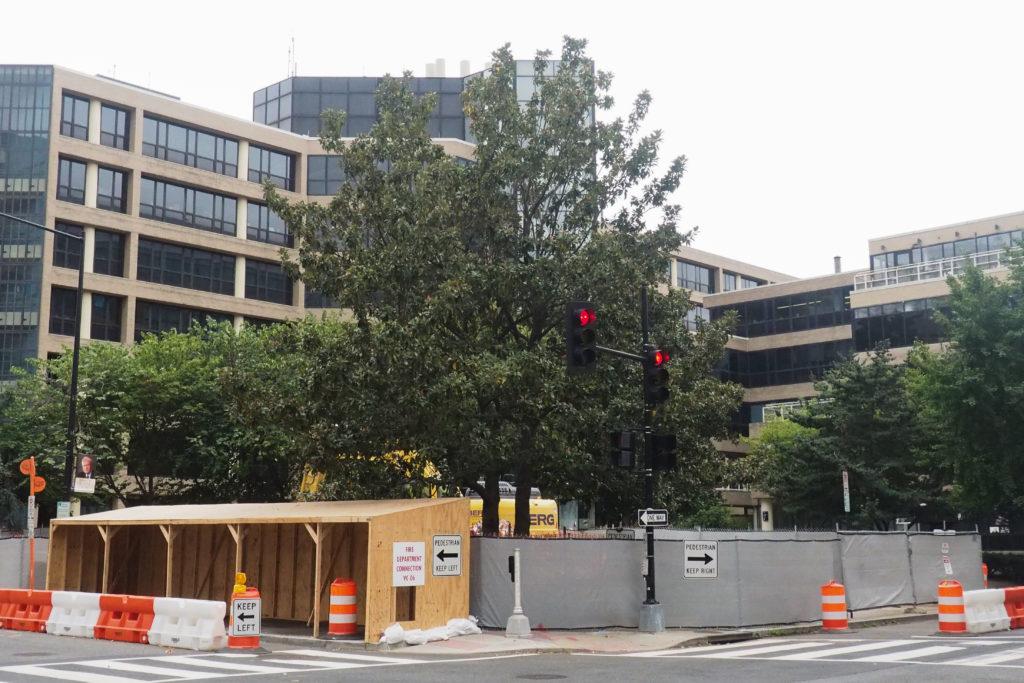Officials have demolished the building that previously housed the Nashman Center for Civic Engagement and Public Service following months of resistance from local residents.
University spokesperson Crystal Nosal said officials started the process to destroy the building, also known as the Waggaman House, late last month and performed the demolition last week. The building’s demise follows a struggle between Foggy Bottom residents who wanted to save the building from destruction and locals who supported using the University’s plan to transform the lot into an area with green space.
Nosal said the contractor performing the demolition has redirected pedestrian traffic onto a temporary protected sidewalk on the street, and the destruction of the building will take place during “allowable work hours” with some noise. She said contractors also built a wooden structure over an exhaust vent on I Street to cover a Metrorail line to prevent debris from entering the grate.
“Standard construction noise is expected, and will take place during allowable work hours,” Nosal said in an email.
Officials announced in February that the building would be demolished and that the space would be converted into an outdoor space for “community use.” Nosal said officials are still developing usage plans for the now-empty lot.
The Foggy Bottom Association tried to save the building from demolition earlier this year, saying the row house needed to be preserved for its “historic” value. Nosal said the University met with concerned residents but continued the precedent of the 2007 Foggy Bottom Campus Plan, which found that the building, which was constructed in 1886, was not eligible for historic preservation.
“The Historic Preservation Plan for the Foggy Bottom Campus identified individual buildings and collections of historic properties and proposed a historic district on the Foggy Bottom Campus as well as the landmark designation of several additional campus buildings beyond those already designated,” Nosal said. “The building at 837 22nd Street was considered as part of this process but did not receive designation as a historic site.”
Margaret McDonald, an Advisory Neighborhood Commissioner whose district encompasses the former building, said she was not in office when plans to destroy the building were finalized, but she supports the demolition nonetheless. McDonald said the demolition of the building gives the University an opportunity to provide more housing space or classrooms, and hopes GW will explore those options in the future.
“I support making a new space where students can study and hang out, but I do think the space could have been utilized for dorm expansion or classrooms,” McDonald said in an email. “Generally, I am glad to see that the project is finally moving forward and something is happening with the space.”
McDonald said she understands the desire to preserve historic buildings in the District, but she thought the space needed to be used for something new, like park space or other student accommodations.
“I understand concerns about preserving historic buildings in D.C., however, this space needs to be utilized for something new,” McDonald said. “The Nashman Center no longer resides within the building, and there is potential in creating a new park in the area instead.”
James Harnett, a former ANC commissioner who used to represent the area where the lot is located, said he supports the demolition of the building because of the opportunities it provides to expand classroom and learning spaces for students. He said concerns that the University is destroying a historic building are unfounded and that the building’s age doesn’t automatically make it a historic site.
“There are folks that would like to say that this is a tragedy and this is a step backwards for the neighborhood, and that just couldn’t be further from the truth,” Harnett said.
Harnett said the plans to use the new open space as an expanded park for several years is an “excellent” idea and hopes GW will build new facilities for Columbian College of Arts and Sciences students, who he believes deserve new learning spaces.
“We need to make sure that students, the very foundation of this neighborhood, have the space to learn that they need to feel valued and respected.”
John George, the president of the Foggy Bottom Association, wrote a letter to the ANC in March, asking them to call on GW to preserve the row house, which is the last remaining Foggy Bottom row house of the 11 that were built by developer Thomas Waggaman in 1886.
“The building is gone,” he said in an email. “I am not sure what more there is to say.”








